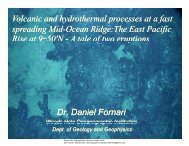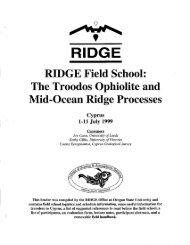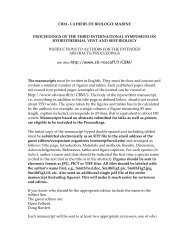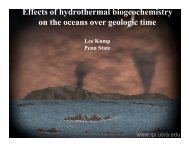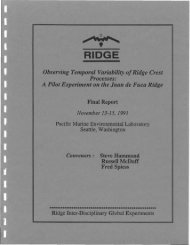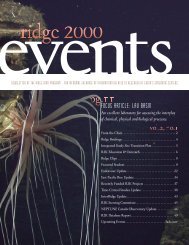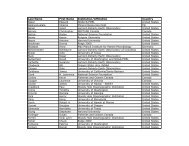Create successful ePaper yourself
Turn your PDF publications into a flip-book with our unique Google optimized e-Paper software.
GROUP 4:<br />
SUBSEAFLOOR HYDROTHERMAL PROCESSES<br />
Members:<br />
Johnson Cann. Co-Chairman<br />
John Edmond. Co-Chairman<br />
Alan Chave. John Delaney. David Janecky.<br />
Marc Langseth. Robert Lowell. Russell McDuff.<br />
Peter Rona. William Seyfried. Wayne Shanks.<br />
Norman Sleep. Geoffrey Thompson. Richard von Herzen<br />
Motivation and Goals<br />
Seafloor hydrothermal systems are a central component of a<br />
dynamic process that transfers energy and mass through the crust<br />
of the earth. Chemical and thermal exchanges between the ocean<br />
and the oceanic crust in hydrothermal systems play a major role<br />
in the cooling of the earth. the genesis of many types of ore<br />
deposits. control of geochemical mass balances that influence<br />
the composition of the oceans. and the ecology of associated<br />
chemosynthetic animal communities. An order of magnitude<br />
estimate of the flow rate of seawater shows that the entire<br />
ocean is cycled through the oceanic crust every few million<br />
years. equivalent to a flow rate of several million gallons per<br />
second. The thermal power output of this system is about 10<br />
million megawatts. Previous and current research on seafloor<br />
hydrothermal systems has begun to address the complexity of the<br />
physical. chemical. and biological components involved in the<br />
interactions between circulating seawater and the lithosphere.<br />
New approaches are required to understand the physics and<br />
chemistry of t.he individual processes which produce t.emporal and<br />
spatial variability of hydrothermal circulation. and the<br />
geological products of rock-water interactions.<br />
Rocks and sediments which make up the seafloor are permeable.<br />
allowing wat.er to penetrate t.hrough t.he seafloor and into<br />
the oceanic lithosphere. The downwelling seawater is heated<br />
when it. flows near the magmat.ic sources which drive hydrothermal<br />
circulation. The most prominent locus of magmatic activity is<br />
the ridge system which extends through all the ocean basins. In<br />
addition. magmatic activity is associated with volcanic centers.<br />
Research into hydrothermal flow complements the investigations<br />
of magmatic systems proposed by Working Groups 1 and 2 and will<br />
reveal the intertwined dynamics of the magma-hydrothermal system.<br />
In fact. it is likely that hydrothermal activity strongly<br />
affects the depth and geometry of crustal magma chambers on<br />
mid-ocean ridges. A primary objective in the future study of<br />
the global mid-ocean ridge system is to understand the physical.<br />
chemical. and biological processes involved in the interactions<br />
between circulating seawater and the lithosphere.<br />
38






